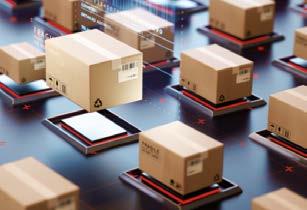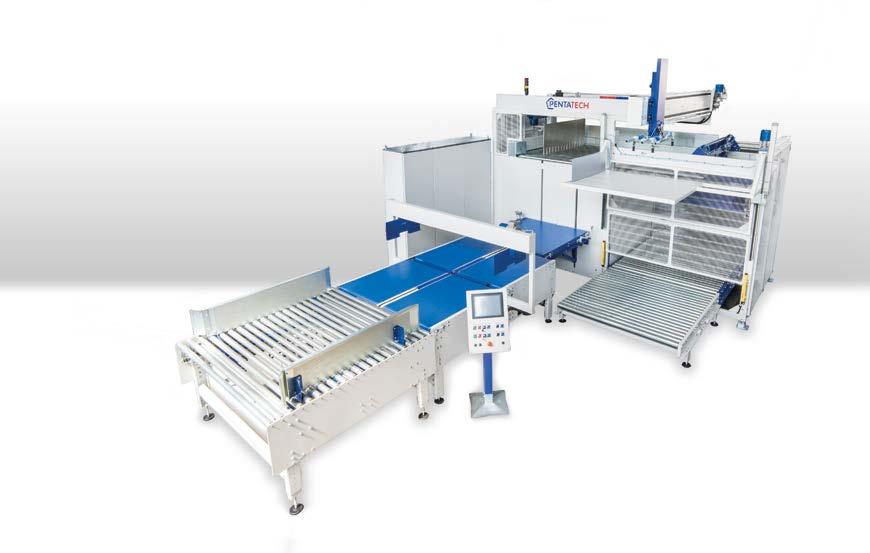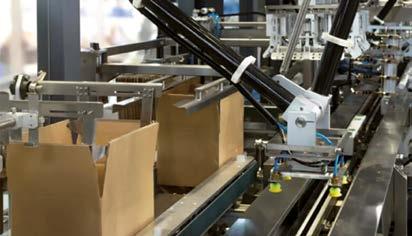
6 minute read
Come affrontarla con un ecosistema integrato Digital transformation and smart manufacturing in the packaging market - How to deal with it with an integrated ecosystem
reparti produttivi ma da ogni business unit aziendale. Diventa necessario imparare a comprendere i segnali che ci comunicano questi dati, trasformarli in un capitale informativo al centro della strategia e al servizio dei decisori aziendali. Spostando il focus sul settore Packaging, un aspetto importante della trasformazione digitale è la sua estensione al mondo della fabbrica che Sirio applica, secondo il paradigma dell’Industria 4.0, con particolare riferimento a:

Advertisement
• MANUFACTURING EXECUTION SYSTEM (MES) PAPER NG, il MES di Sirio si collega alle linee di produzione e acquisisce in modalità automatica i dati dalle linee di produzione per metterli a disposizione in tempo reale dei sistemi APS (Scheduling) e ERP (Gestionale in ottica IT/OT Integration Industry 4.0); • ENTERPRISE RESOURCE PLANNING (ERP) SIPAC (Sistema Informativo Packaging) è I’ERP dedicato a ondulatori, scatolifici e stabilimenti integrati che si occupano sia della produzione di cartone che di imballaggi. Consente di aggregare i dati di vendita, acquisto e produzione per generare preventivi, emettere ordini e fatture con la possibilità di allegare qualsiasi tipologia di documento, archiviare in formato digitale e gestire magazzini complessi. Gli ordini possono essere confermati e firmati digitalmente anche in mobilità da dispositivi mobile, come smartphone e tablet. Infine, le funzioni di Business Intelligence si avvalgono degli appositi KPI (Key Performance Indicator) del manifatturiero, e in particolare del cartario, riconducibili ai tre coefficienti - disponibilità, efficienza e qualità - dell’indicatore OEE (Overall Equipment Effectiveness);
• ADVANCED AUTOMATION - ADVANCED HMI (ADVANCED HUMAN MACHINE INTERFACE) Con i Bordi Macchina di PAPER NG l’operatore di macchina conosce in tempo reale la performance della lavorazione mediante rappresentazione grafica e a valore delle prestazioni reali rispetto a quelle teoriche, conosce la disponibilità delle attrezzature ed eventuali criticità sugli impianti che gli consentono di effettuare in tempi rapiti le azioni correttive.
ENGLISH Version Digital transformation and smart manufacturing in the packaging market - How to deal with it with an integrated ecosystem
AN EPOCHAL TRANSITION IS AFFECTING ALL INDUSTRIAL SECTORS: DIGITAL TRANSFORMATION. EVEN THE TRADITIONAL MANUFACTURING SECTORS AND THOSE FURTHEST FROM NEW TECHNOLOGIES MUST FACE THIS TRANSFORMATION TO PROTECT THEIR COMPETITIVENESS ON THE MARKETS
Digital Transformation is a challenge that does not only concern the technologies or strategies of the company, but that affects all the human resources of the organization enriched by the right skills. In this digital transformation, a series of technological, cultural, organizational, creative and managerial changes must therefore be considered. In fact, we are not talking about a simple technological update but a real paradigm change that must be promoted and supported from above but which affects all subjects and company divisions, in a joint action of reorganization of skills in a digital key. In fact, digital transformation requires the right corporate culture to support it. Given this important condition, what are the technological pillars to engage a digital transformation path? A research carried out by the Digital360 Network identifies six pillars: 1. Work automation: for faster processes, error reduction and efficiency 2. Computerization: a new intelligence in the governance of processes 3. Dematerialization: of processes and documents with related new logic of sharing and integration between workers 4. Virtualization: transforming physical resources into virtual resources to use
them with greater flexibility Applying and managing this new paradigm in organizations involves the definition of a shared business project. Digitized processes produce an enormous amount of data, generated not only by the production departments but by every business unit in the company. It becomes necessary to learn to understand the signals that these data communicate to us, transform them into an information capital at the heart of the strategy and at the service of corporate decision makers. Shifting the focus to the Packaging sector,




• COGNITIVE COMPUTING - COGNITIVE
MANUFACTURING Il MES PAPER NG riprogramma la produzione sulla base dei dati rilevati automaticamente dalle macchine e in relazione ai parametri di configurazione degli impianti e delle schede di lavorazione dei prodotti.
Scarica il White Paper “Guida alla transizione verso l’Impresa 4.0: cartone ondulato, imballaggi, carta e tissue” • COLLABORATIVE MANUFACTURING -
IT/OT INTEGRATION Grazie a un evoluto sistema di IT/OT Integration, basato su tecnologie XML e Database To Database, il MES PAPER NG consente un controllo immediato di fattibilità di una commessa di produzione e la visibilità in tempo reale dello stato avanzamento e di eventuali criticità a tutti i livelli del sistema informativo, gestionale / produttivo / logistico.
• INDUSTRIAL ANALYTICS PAPER NG mette a disposizione di tutti i livelli aziendali le informazioni necessarie a supporto delle decisioni tramite analisi sulle linee di produzione, sulle commesse di produzione e sui prodotti; con l’ausilio di KPI - Key Performance Indicators - e con il calcolo degli O.E.E - Overall Equipment Effectiveness.
WEBINAR DI APPROFONDIMENTO – 28 ottobre 2020 Industria 4.0 Carta e Packaging: produzione e logistica in un ecosistema integrato
an important aspect of the digital transformation is its extension to the world of the factory that Sirio applies, according to the Industry 4.0 paradigm, with particular reference to:
• MANUFACTURING EXECUTION
SYSTEM (MES) PAPER NG, Sirio’s MES, connects to the production lines and automatically acquires data from the production lines to make them available in real time to the APS (Scheduling) and ERP (Management from IT / OT Integration Industry 4.0) systems;
• ENTERPRISE RESOURCE
PLANNING (ERP) SIPAC (Packaging Information System) is the ERP dedicated to corrugators, box factories and integrated factories that deal with both cardboard and packaging production. It allows you to aggregate sales, purchase and production data to generate quotes, issue orders and invoices with the ability to attach any type of document, archive in digital format and manage complex warehouses. Orders can be confirmed and digitally signed even on the move from mobile devices, such as smartphones and tablets. Finally, the Business Intelligence functions use specific KPIs (Key Performance Indicators) of manufacturing, and in particular of Paper market, attributable to the three coefficients - availability, efficiency and quality - of the OEE (Overall Equipment Effectiveness) indicator;
• ADVANCED AUTOMATION -
ADVANCED HMI (ADVANCED HUMAN
MACHINE INTERFACE) With PAPER NG terminals, the machine operator knows in real time the processing performance through graphic and value representation of the real performances compared to the theoretical ones, he knows the availability of the equipment and any critical issues on the systems that allow him to carry out in time kidnapped the correct corrective actions. • COGNITIVE COMPUTING -
COGNITIVE MANUFACTURING The MES PAPER NG reprograms the production on the basis of the data automatically detected by the machines and in relation to the configuration parameters of the systems and of the product processing cards.
• COLLABORATIVE MANUFACTURING - IT / OT INTEGRATION Thanks to an advanced IT / OT Integration system, based on XML and Database To Database technologies, PAPER NG allows immediate feasibility check of a production order and real-time visibility of the progress and any critical issues at all levels of the information, management / production / logistics system.
• INDUSTRIAL ANALYTICS PAPER NG provides all company levels with the information necessary to support decisions through analysis on production lines, production orders and products; with the help of KPI - Key Performance Indicators and with the calculation of O.E.E - Overall Equipment Effectiveness.











